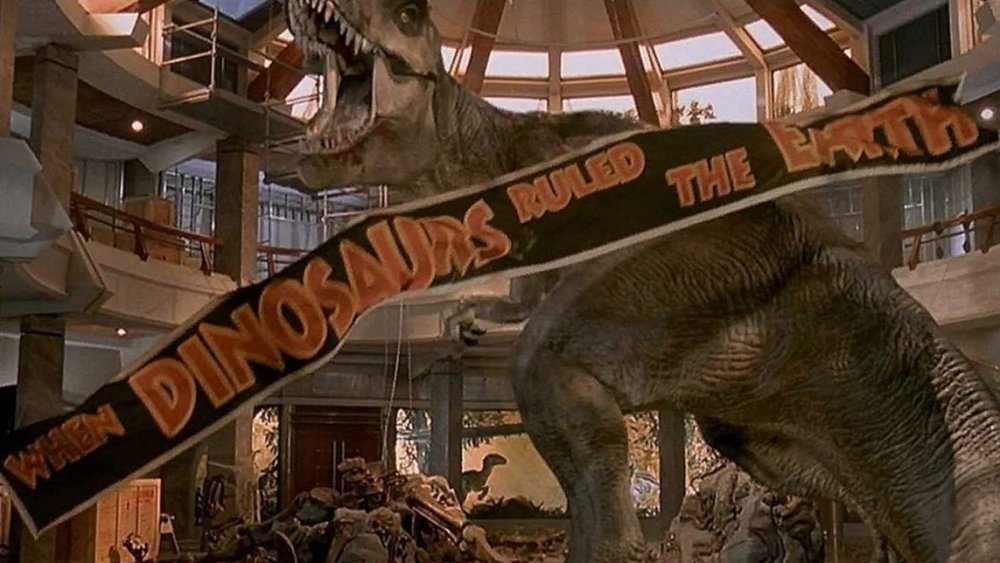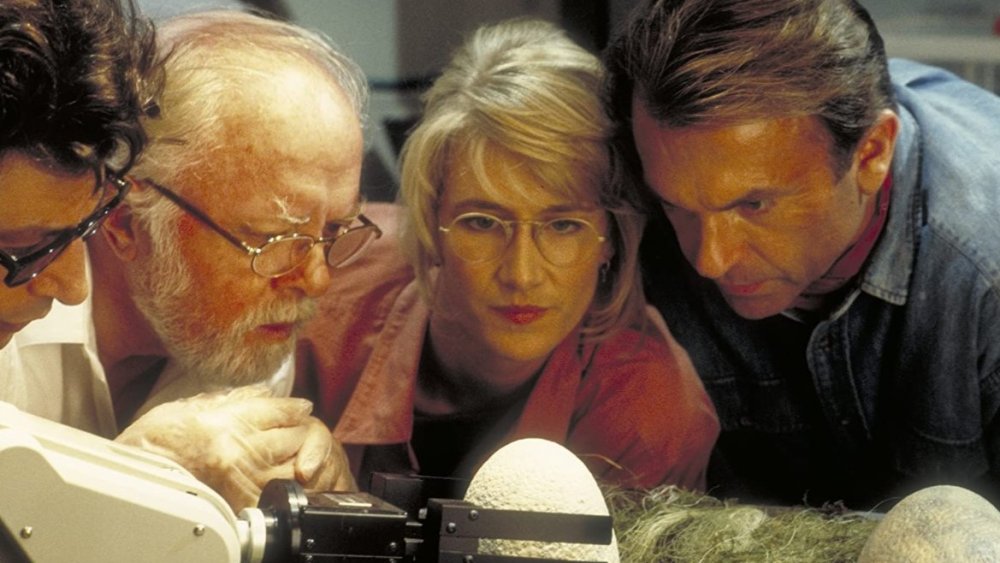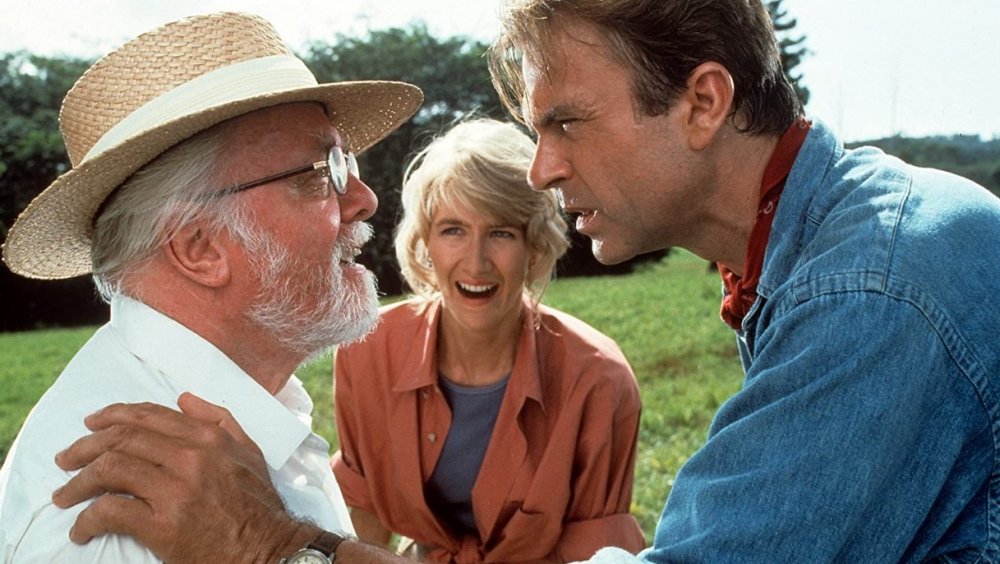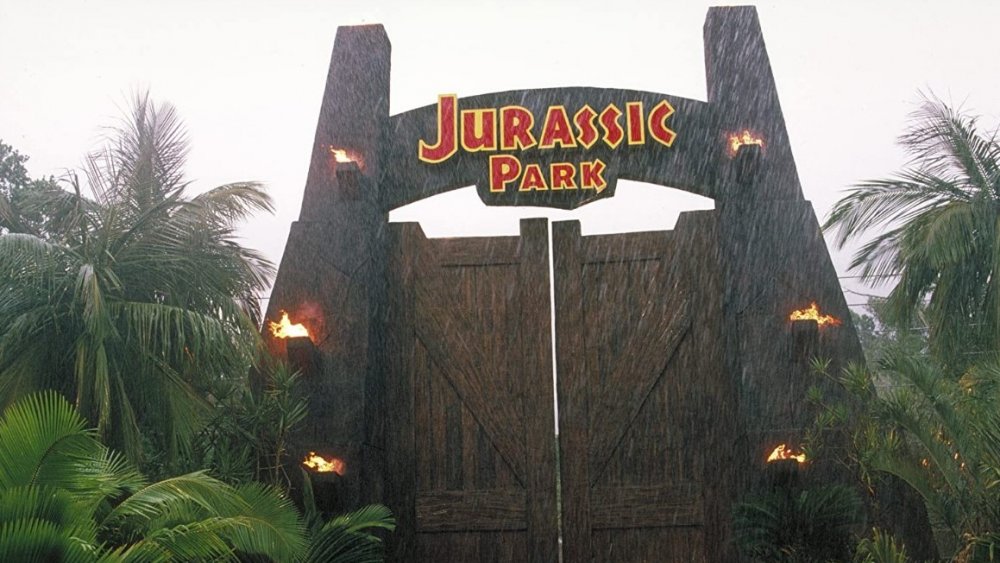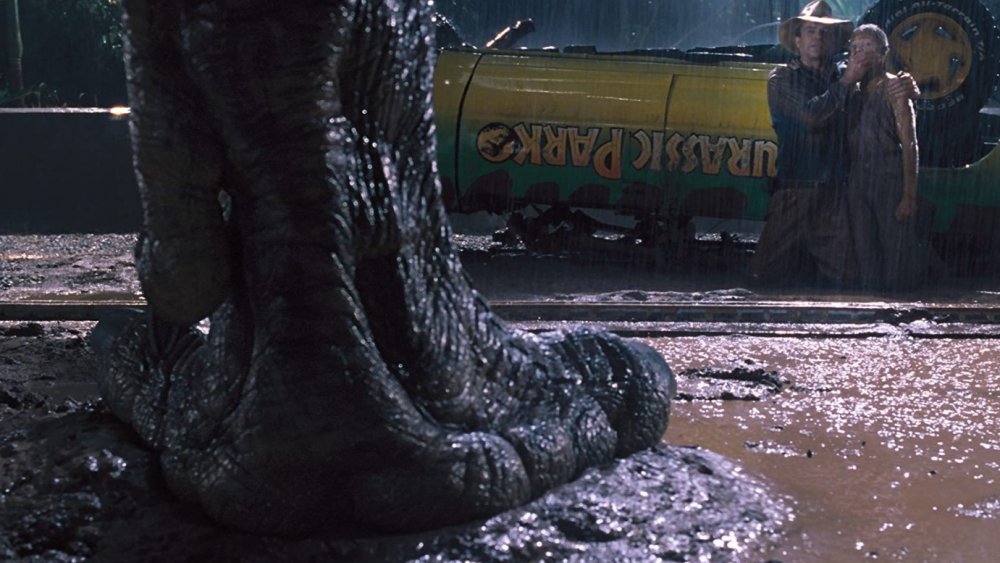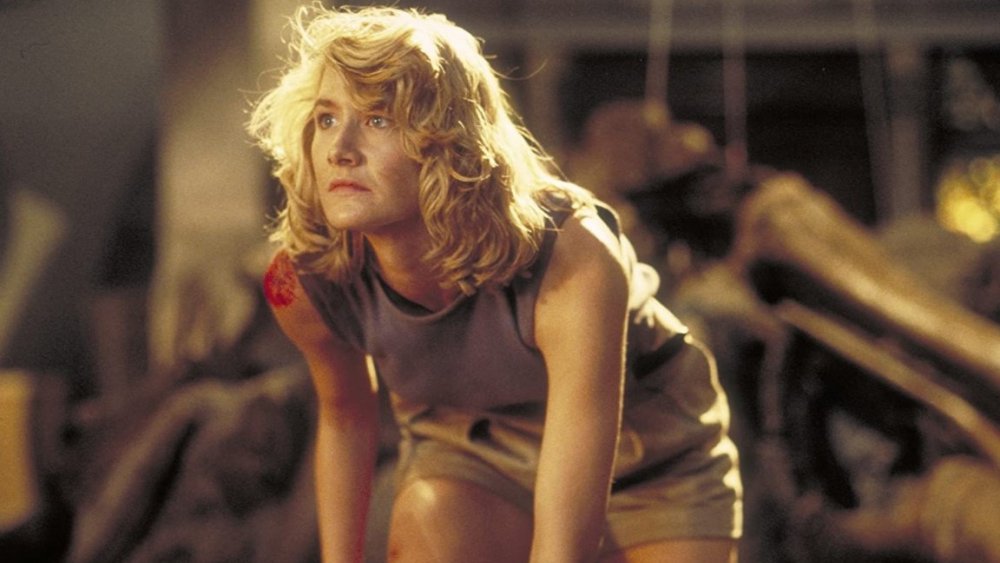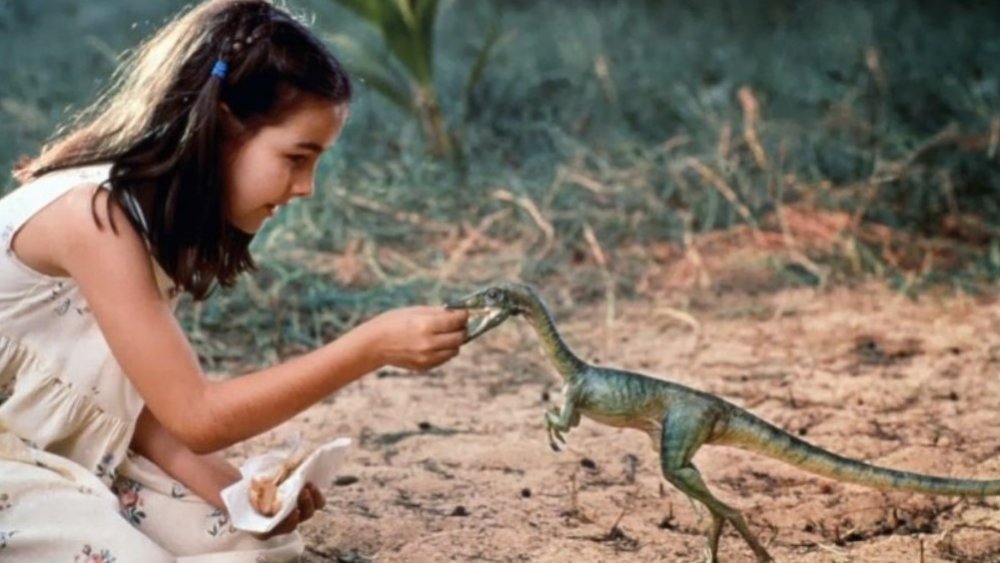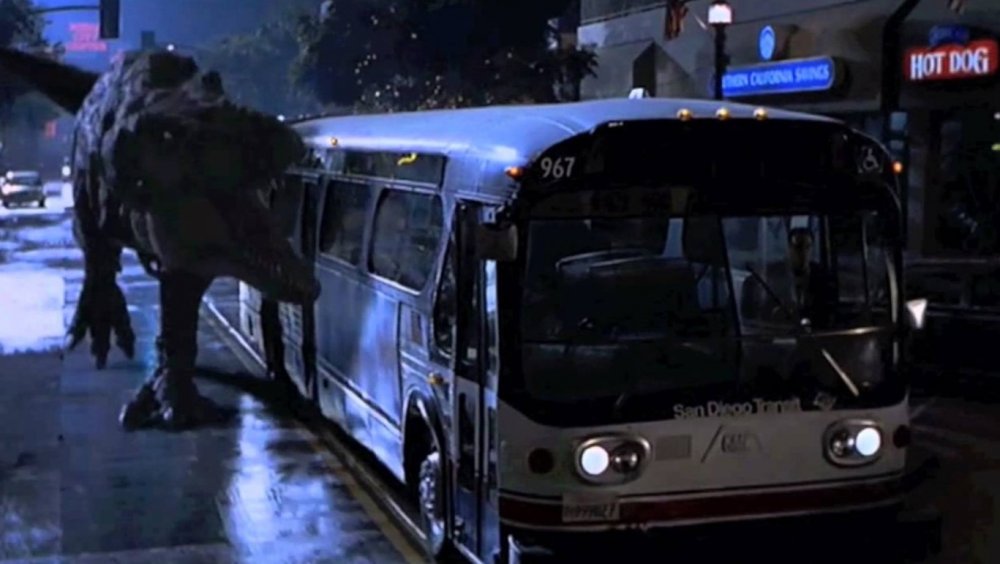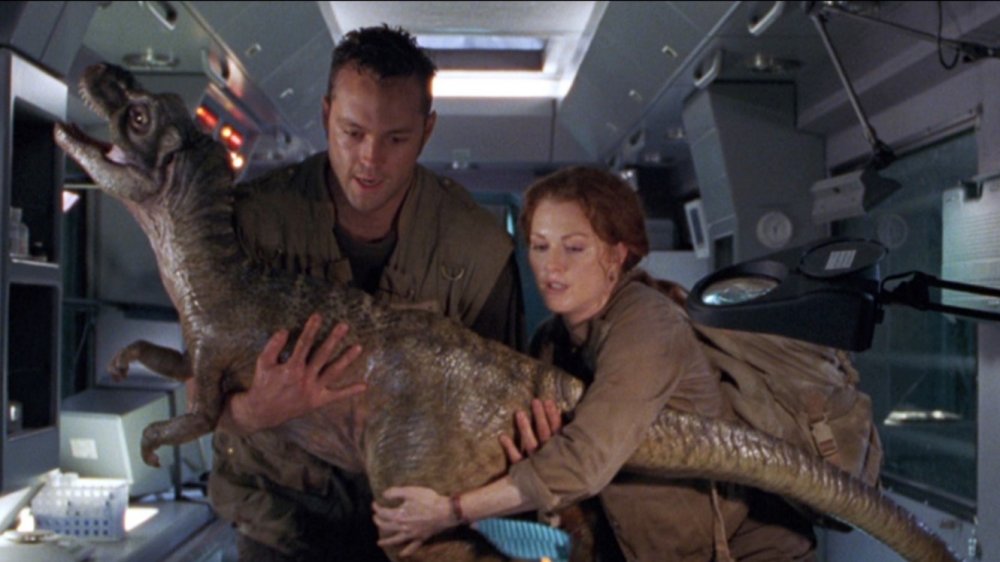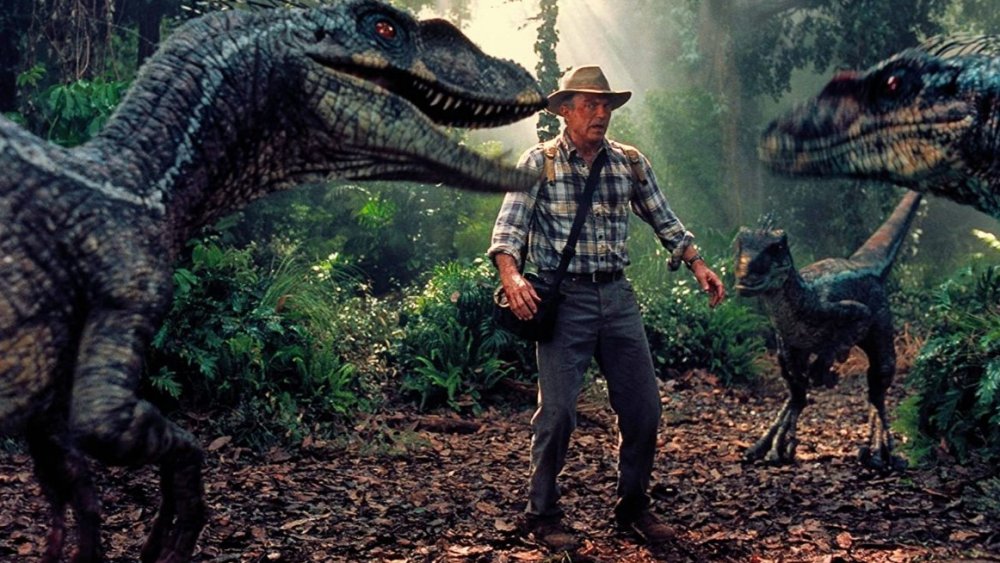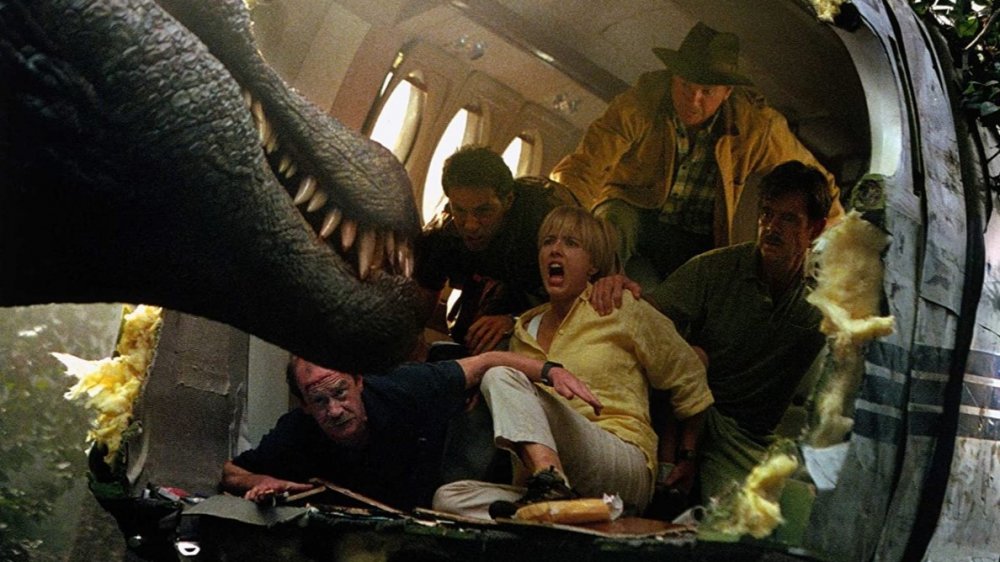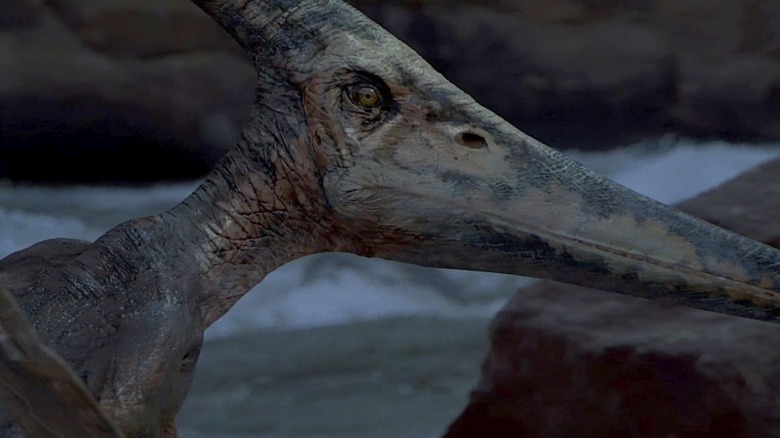Inside The Original Jurassic Park Trilogy
In 1993, the film Jurassic Park promised to take audiences back to the time when dinosaurs walked the Earth — albeit in an isolated theme park where the humans evaluating the place fall prey to Murphy's Law. Director Steven Spielberg's sci-fi action-adventure spliced together what he called "a helluva yarn" with Oscar-winning special effects that still wow audiences today. Spielberg knew from the outset that the beasts were the draw: "These were the stars of the picture, these dinosaurs. And if that didn't work, nothing about Jurassic Park could have worked," Spielberg recalled in an Entertainment Weekly oral history of the film.
Like a nine-ton T. Rex in a fossil exhibit, Jurassic Park smashed box office records at the time, earning $47 million its first weekend and later more than $900 million worldwide. It also left an indelible footprint on pop culture, hatching two sequels — 1997's The Lost World: Jurassic Park and 2001's Jurassic Park III – and inspiring the Jurassic World series. Even after all these years, the original film, now a part of the National Film Registry of the Library of Congress, thrills thanks to its mix of awe, suspense, jolts, and characterization that nevertheless keeps the lifelike dinosaurs the main attraction. While we wait for what else the newer franchise has on the menu, let's go inside the original Jurassic Park trilogy.
The germ of an idea
Tracking the inspiration for Jurassic Park leads to Spielberg's love of dinosaurs as a child. "I was more interested in the dinosaurs in King Kong than I was in King Kong himself," recalled the director, who even collected cast-iron dinosaur figures as a boy. "I thought the T. rex was one of the most awesome dinosaurs of the fossil record!"
In the late 1980s, Spielberg met author and screenwriter Michael Crichton, a Harvard Medical School graduate whose novels (The Andromeda Strain, The Terminal Man, Binary, Congo) often hinge on problems with science. As the two developed a script based on Crichton's time as a medical resident (a project that would become the TV series ER), Crichton mentioned another idea of his: a novel about dinosaurs brought to life through discovered samples of DNA. Considering the gene-editing technology CRISPR, unveiled in 2012, the concept was certainly ahead of its time. The premise instantly piqued Spielberg's interest, and before Crichton had even finished the novel, Universal Studios paid the author $2 million for the film rights and a first draft of the screenplay. Screenwriter David Koepp (Death Becomes Her, 1996's Mission: Impossible, 2002's Spider-Man) later came on board. He streamlined the science and, with Spielberg, came up with the animated Mr. DNA (voiced by Greg Burson, Tiny Toon Adventures) to explain how the fictional theme park spawned dinosaurs in a lab.
Casting the film
In Jurassic Park, wealthy businessman John Hammond (Richard Attenborough) invites paleontologist Dr. Alan Grant (Sam Neill), paleobotanist Dr. Ellie Sattler (Laura Dern), and mathematician Dr. Ian Malcolm (Jeff Goldblum) to the fictional island of Isla Nublar, off Costa Rica, to tour his live-dinosaur theme park and certify that it's safe for the public. Spielberg offered Harrison Ford the role of Grant, but Ford turned it down, paving the way for Neill, who "hadn't read the book, knew nothing about it, hadn't heard anything about it." Laura Dern said yes in part because Nicolas Cage, who had just wrapped Wild at Heart with her, encouraged her to do it.
Jim Carrey gave a "terrific" audition for the ever-quotable Dr. Malcolm, said casting director Janet Hirshenson, but she "loved the idea" of Goldblum right away. As for Hammond, Crichton initially liked Sean Connery, whom Crichton directed in 1978's The Great Train Robbery, based on his 1975 novel. Plus, Spielberg liked Attenborough's ambivalence: "I was much more interested in portraying Hammond as a cross between Walt Disney and [philanthropist and politician] Ross Perot," the director said. "Attenborough sort of keeps you off balance, second-guessing what his motives are."
Fake dinosaurs but a real hurricane
Hawaii, specifically the gorgeous island of Kauai, hosted part of the production. Jurassic Park's locations include Manawaiopuna Falls, where the helicopter lands with Hammond and his guests, and the Puu Ka Ele Reservoir, where the actors gaped at roaming Brachiosaurus that the special effects team added later. (Red Rock Canyon in California's Mojave Desert filled in for the Montana Badlands, where viewers first see Alan and Ellie at a dig site.)
In the film, a tropical storm strikes the island, ramping up the suspense as the power fails. In real life, the production faced Hurricane Iniki, which made landfall at Kauai in September 1992 with winds of over 140 mph. Spielberg turned on the hotel TV early one morning to see the weather report, complete with "the icon of a cyclonic hurricane moving directly towards us. It was like a movie." The cast and crew huddled in a hotel ballroom for safety, although some shot footage of the approaching storm that ended up in the final film. "[Producer] Kathleen Kennedy got a lot of people off the island and onto army transports right before the hurricane hit, but it exfoliated the entire island. It was really bad," recalled Wayne Knight (TV's Seinfeld), who played industrial saboteur Dennis Nedry. More than 1,400 houses were destroyed, and six people died.
Larger-than-life effects
Bringing Jurassic Park's dinosaurs to life took a multifaceted approach that netted the film three Academy Awards for its visual effects, sound, and sound effects editing. Legendary creature designer and special effects creator Stan Winston (Aliens, Terminator 2: Judgment Day) created large-form models of dinosaurs, including one of Tyrannosaurus rex that was nearly 20 feet tall. "I used to be enthralled with dinosaurs like a lot of kids," Jeff Goldblum recalled to EW. "So cut to me in Hawaii coming on the set and seeing that thing already fully there and the puppeteers — one working the eyes, one doing the breathing. For all the world, it was a live dinosaur sitting there. Amazing."
Stop-motion artist Phil Tippett (RoboCop) animated miniatures of Winston's designs for some of the action sequences; he sent the animators to mime classes to help make the dinosaurs' movements more fluid. The production also used computer-generated dinosaurs, notably during the Gallimimus stampede. When Spielberg asked Tippet how he felt after seeing the CG footage of the stampede, "I said, 'I think I'm extinct,'" Tippett recalled. "He said, 'That's a great line. I'm putting that in the movie.'" As for the dinosaurs' snorts, roars, and other sounds, sound designer Gary Rydstrom said he wanted to "stay organic," so he used sounds from real animals — about 20 or 30 animal sounds alone for the raptors, including a combination of walrus and dolphin for the main "attack scream."
Palpable awe and layers of subtext
One reason for Jurassic Park's enduring appeal is the cast's genuine awe, even when they weren't sure how the final footage would look. Dern remembered how she and Neill couldn't help but hug the lifelike triceratops puppet. "We were both freaking out. And like Sam [Neill] does in the movie, we did lay ourselves over the belly and feel the belly moving in and out," she said, adding that she "forced" the puppeteers to let her see how it worked. When Spielberg asked Neill to imagine how he'd feel upon seeing grazing dinosaurs, the actor said he thought he'd faint: "That's why my knees go in the shot."
Yet for all its grand scale, Spielberg saw the film as more than a monster mash: "This film is more like [mystery writer Agatha Christie's] Ten Little Indians than it is Godzilla attacking Tokyo. ... There's a presumption in this genre that the more invasive the people in an environment are, the more ill-equipped they are to survive it, and the more the audience feels they deserve what's coming." Certainly Crichton, who wrote and directed 1973's Westworld about another theme park gone awry, liked to explore technology's perils. But the film also can be read as a metaphor for reproductive fears and patriarchal control, thanks to geneticist Dr. Henry Wu (B.D. Wong) asserting that the park's animals are "engineered" to be female. "There's no unauthorized breeding in Jurassic Park," Wu says. "We simply deny them that."
More classic homages than Michael Crichton
Because of Jurassic Park's popularity, Spielberg was happy to sign on for a sequel. "The idea of being inside a prehistoric world that exists somewhere in this world today — that really compelled me. And I thought, wow, what a great story," he explained in a making-of featurette. For 1997's The Lost World: Jurassic Park, the director and returning screenwriter Koepp adapted only pieces of Crichton's 1995 novel The Lost World, which itself took its title from Sir Arthur Conan Doyle's 1912 dinosaur tale.
The story this time around involved Hammond (Attenborough) hiring Ian (Goldblum) to join an expedition of dinosaur advocates at a second island, Isla Sorna, where his company had conducted its research in secret. A storm has left the island's creatures running wild, something people discover after a vacationing family stops there for a picnic and the turkey-sized Compsognathus eyeball their daughter as a snack. Ian agrees after learning that his paleontologist girlfriend, Sarah Harding (Julianne Moore, Far from Heaven), is already there — along with a cadre of dinosaur hunters including Roland Tembo (Pete Postlethwaite). The sequel weaves in homages to classic films and monster movies, including the big-game plot of 1962's Hatari and 1961's Gorgo, in which a prehistoric mother wrecks London to retrieve her baby — much like the mama T. rex during the Lost World climax rampages through San Diego in pursuit of her child.
A darker mood
Planning The Lost World: Jurassic Park took at least two years, including designing the action set pieces and building the creatures. Although the film used more CGI, Winston returned to develop the animatronics. "We certainly wanted to raise the stakes, you know, where Stan Winston was concerned because he had the chance to make dinosaurs that were even more lifelike, and he really did that," Spielberg pointed out. To map out the logistics of the complex action sequences, the crew used almost 1,500 storyboards.
Spielberg also trusted cinematographer Janusz Kaminski, who won an Academy Award for his work on Spielberg's Oscar-winning 1993 film Schindler's List, to create a darker look for this film compared to the original. "Jurassic Park was very much like an amusement park ride. The images were brighter, more colorful and more friendly. This film is much more moody and violent," Kaminski said, noting that he found inspiration in films such as 1982's Blade Runner, 1979's Alien, 1954's Godzilla, and 1933's King Kong.
Not quite a 'slam dunk'
The Lost World: Jurassic Park earned about $618 million worldwide on an estimated budget of $73 million — a box office hit if a mixed bag for critics, who found the characterization lacking and the story beats "perfunctory." The cast seemed enthralled by the experience, with behind-the-scenes footage showing Spielberg embracing Attenborough (who died in 2014) while Goldblum chuckles over the older man's intonation behind his famous line: "Welcome to Jurassic Park." Although Moore called The Lost World "the most physically demanding film I've ever done," she also found her animatronic co-stars enchanting: "I had a scene with a baby stegosaurus. She had a whole personality. ... You didn't have to do anything but just play the scene with her."
Nevertheless, looking back on his career in 2016, Spielberg told the New York Times that The Lost World was an example of his enthusiasm getting the better of him. "My sequels aren't as good as my originals because I go onto every sequel I've made and I'm too confident," he explained. "This movie made a ka-zillion dollars, which justifies the sequel, so I come in like it's going to be a slam dunk and I wind up making an inferior movie to the one before. I'm talking about The Lost World and Jurassic Park."
Back to the jungle
For 2001's Jurassic Park III, Spielberg remained as an executive producer but handed directing duties to Joe Johnston. He'd worked with Spielberg as a visual effects artist on Raiders of the Lost Ark before directing 1989's Honey, I Shrunk the Kids, 1991's The Rocketeer, and 1995's Jumanji. Johnston had been eager to work on a sequel ever since Jurassic Park took off and was first on Spielberg's list for this project, according to Kennedy. Neill liked Johnston's enthusiasm and "sheer sense of mischief." The actor told the BBC he was excited to return to the franchise because "I wasn't quite happy with what I'd done with the character in the first film. I was so over-awed by Spielberg; I think I didn't quite look after my guy as well as I might have."
Getting Alan back to the island proved problematic at first, though. The story went through several drafts, including one with teenagers stranded on Isla Sorna, the island from The Lost World: Jurassic Park, that Johnston said "read like a bad episode of Friends." The filmmakers scrapped another version that had been planned and storyboarded — with $18 million already spent – about five weeks before filming began. Koepp suggested keeping the story simple, and the script credited to Peter Buchman (Eragon), Alexander Payne (Election), and Jim Taylor (Sideways) ultimately had an estranged couple (William H. Macy and Téa Leoni) hiring Alan to help rescue their son, who'd become stranded on Isla Sorna after parasailing nearby.
A bumpy ride
Even with an estimated budget of $93 million, Jurassic Park III had a rough start because of its unfinished script. "We didn't have an ending that we liked the first time we were there," Johnston told EW as Leoni chimed in: "We just had the ending missing? Joe is being graceful. We started in Hawaii with no ending, the middle a little up in the air, and the beginning, uh, pretty solid."
The constant revisions proved stressful, with Macy) telling TV Guide, "The script has been evolving and being rewritten as we go, and what you want to say is, 'Who launched a $100 million ship without a rudder, and who's getting fired for this?'" Johnston later chalked up Macy's comments to being interviewed on "a bad day," noting that Macy had been a "trouper" who "never refused to do anything." Regardless, the director acknowledged in Starlog magazine that the 16 or so weeks of shooting were "grueling," with the actors "never comfortable. They were always wet. They were always in mud. They were hanging in trees. They were underwater. They were running falling, getting stepped on, and getting trapped in places." For one sequence in which the crew tumbled the cast around in what would be the fuselage of a crashed plane, Johnston said, "I don't know how the actors got out without broken arms and amputations."
New creatures take flight
Laura Dern also returned to Jurassic Park III as Ellie Sattler, but with her character being married and mom to a young son, she missed out on the stunt work. Ellie was still close friends with Alan, though, and provided a helping hand from afar in the last act. "[W]e shot all of her stuff in one day," Johnston said.
Just as with the two films, the special effects crew didn't disappoint, with roughly 400 shots involving CGI, some of those adding upper bodies to the animatronic feet of Winston's designs. The artists were determined to show dinosaurs that audiences hadn't seen before, such as ankylosaurs, Pteranodons in a wrecked aviary, and the Spinosaurus, which paleontologist and consultant Jack Horner suggested, calling it "a massive carnivore with the snout of a crocodile, a back fin resembling that of a Dimetrodon, and the ferociousness of the Tyrannosaurus." Upon its release, the film earned about $365 million worldwide — along with the high of a BMI Film Music Award for composers Don Davis and John Williams and the low of a Razzie Award nomination for "Worst Remake or Sequel." Regardless, when Macy looked back on the whole experience, he had nothing but positive things to say.
